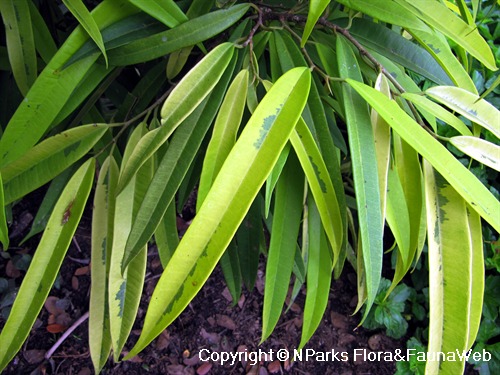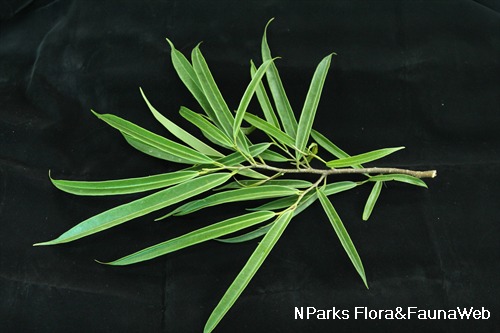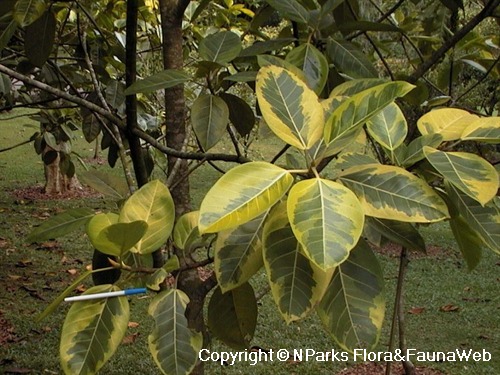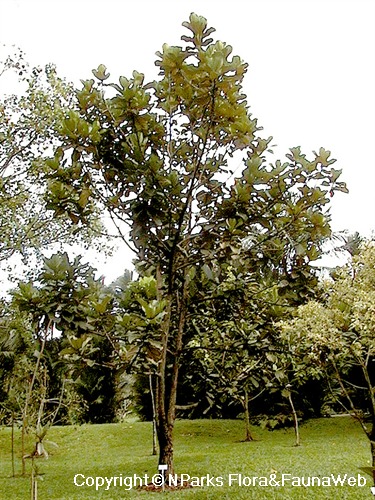
Back
Ficus maclellandii King
| Family Name: | Moraceae |
| Synonyms: | Ficus rhododendrifolia (Miq.) Miq., Ficus thorelii Gagnep. |
Name
Classifications and Characteristics
| Plant Division | Angiosperms (Flowering Seed Plants) (Dicotyledon) |
|---|---|
| Plant Growth Form | Tree (Medium (16m-30m)) |
| Lifespan (in Singapore) | Perennial |
| Mode of Nutrition | Autotrophic |
| Plant Shape | Irregular |
Biogeography
| Native Distribution | From northeast India, to Myanmar, south China, south to Indochina, Thailand and Peninsular Malaysia in Kedah. |
|---|---|
| Native Habitat | Terrestrial |
| Preferred Climate Zone | Tropical, Sub-Tropical / Monsoonal |
| Local Conservation Status | Non-native (Horticultural / Cultivated Only) |
Description and Ethnobotany
| Growth Form | It is a latex-containing, strangling fig up to 25 m tall, with few, slender aerial roots reaching the ground. |
|---|---|
| Foliage | Its spirally arranged, stalked leaves have thinly to thickly leathery leaf blades that are oblong to oval to lance-shaped or slightly ovate, and 10–18 by 4–7 cm. |
| Flowers | The plant is dioecious with each plant bearing male or female flowers. The flowers are tiny and develop within the syconium (fig). |
| Fruit | Its round syconia (figs) are up to 3 mm wide, and develop in pairs at the leaf axils. It is yellow to red, with a flat or swollen opening at the apice (ostiole) when mature. |
| Habitat | It grows in forests and on limestone at low altitudes. |
| Associated Fauna | Its flowers are pollinated by fig wasps. The ripe figs are eaten by frugivorous birds and mammals. |
| Cultivation | It can be propagated by seed or stem cuttings. |
| Etymology | Latin Ficus, the commercial edible fig (Ficus carica); Latin maclellandii, after John McClelland, a British medical doctor and plant collector (1805–1883). |
Landscaping Features
| Landscaping | It may be suitable for parks. |
|---|---|
| Desirable Plant Features | Ornamental Foliage |
| Landscape Uses | General, Parks & Gardens, Small Gardens |
Fauna, Pollination and Dispersal
| Fauna Pollination Dispersal Associated Fauna | Bird-Attracting (Fruits) |
|---|---|
| Pollination Method(s) | Biotic (Fauna) (Insects (Ant, Beetle, Fly, Thrip, Wasp)) |
| Seed or Spore Dispersal | Biotic (Fauna) (Vertebrates (Bat), Vertebrates (Other Mammal)) |
Plant Care and Propagation
| Light Preference | Full Sun, Semi-Shade |
|---|---|
| Water Preference | Moderate Water |
| Plant Growth Rate | Moderate |
| Rootzone Tolerance | Moist Soils, Well-Drained Soils |
| Propagation Method | Seed, Stem Cutting |
Foliar
| Foliage Retention | Evergreen |
|---|---|
| Mature Foliage Colour(s) | Green, Yellow / Golden |
| Mature Foliage Texture(s) | Leathery |
| Foliar Type | Simple / Unifoliate |
| Foliar Arrangement Along Stem | Alternate |
| Foliar Attachment to Stem | Petiolate |
| Foliar Shape(s) | Non-Palm Foliage (Ovate, Lanceolate, Elliptical) |
| Foliar Venation | Pinnate / Net |
| Foliar Margin | Entire |
Floral (Angiosperm)
| Flower & Plant Sexuality | Unisexual Flowers , Monoecious |
| Flower Grouping | Cluster / Inflorescence |
|---|
| Flower Location | Axillary |
| Inflorescence Type | Syconium |
Fruit, Seed and Spore
| Mature Fruit Colour(s) | Red, Yellow / Golden |
|---|---|
| Fruit Classification | Multiple Fruit |
| Fruit Type | Fleshy Fruit , Accessory / False Fruit (Pseudocarp) |
Image Repository
Others
| Master ID | 29862 |
|---|---|
| Species ID | 4171 |
| Flora Disclaimer | The information in this website has been compiled from reliable sources, such as reference works on medicinal plants. It is not a substitute for medical advice or treatment and NParks does not purport to provide any medical advice. Readers should always consult his/her physician before using or consuming a plant for medicinal purposes. |








